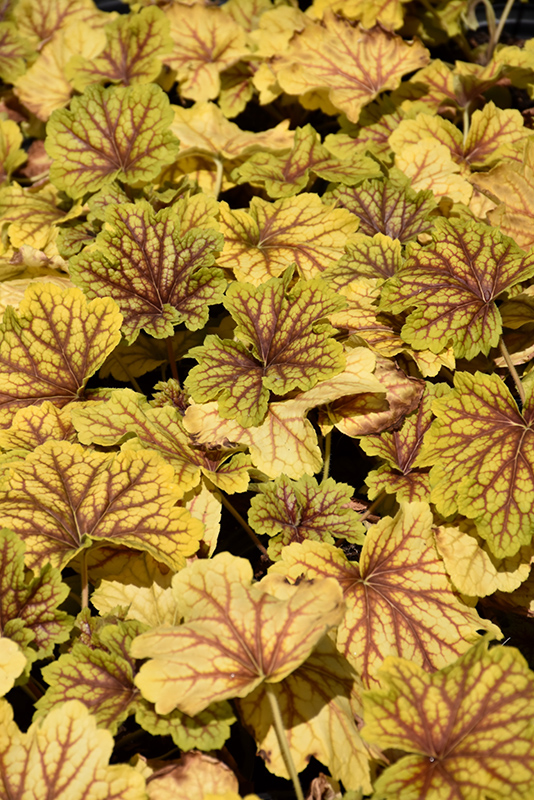Find Plants
Red Lightning Coral Bells
Heuchera 'Red Lightning'
Plant Height: 12 inches
Flower Height: 18 inches
Spacing: 14 inches
Sunlight:
![]()
![]()
![]()
Hardiness Zone: 4
Other Names: Coralbells, Alumroot
Description:
Lightly ruffled foliage develops electrifying bright red veins on gold with pale yellow highlights; spikes of ivory bells in summer; amazing contrast to other plants; great versatility; keep soil moist in heat of summer
Ornamental Features
Red Lightning Coral Bells features dainty spikes of white bell-shaped flowers rising above the foliage from early to mid summer. Its attractive crinkled lobed leaves emerge lime green in spring, turning gold in color with distinctive red veins and tinges of buttery yellow the rest of the year.
Landscape Attributes
Red Lightning Coral Bells is a dense herbaceous evergreen perennial with tall flower stalks held atop a low mound of foliage. Its relatively fine texture sets it apart from other garden plants with less refined foliage.
This is a relatively low maintenance plant, and should be cut back in late fall in preparation for winter. It is a good choice for attracting hummingbirds to your yard. It has no significant negative characteristics.
Red Lightning Coral Bells is recommended for the following landscape applications;
- Mass Planting
- Rock/Alpine Gardens
- Border Edging
- General Garden Use
- Groundcover
- Container Planting
Planting & Growing
Red Lightning Coral Bells will grow to be about 12 inches tall at maturity extending to 18 inches tall with the flowers, with a spread of 16 inches. When grown in masses or used as a bedding plant, individual plants should be spaced approximately 14 inches apart. Its foliage tends to remain dense right to the ground, not requiring facer plants in front. It grows at a medium rate, and under ideal conditions can be expected to live for approximately 10 years. As an evegreen perennial, this plant will typically keep its form and foliage year-round.
This plant performs well in both full sun and full shade. However, you may want to keep it away from hot, dry locations that receive direct afternoon sun or which get reflected sunlight, such as against the south side of a white wall. It prefers to grow in average to moist conditions, and shouldn't be allowed to dry out. It is not particular as to soil type or pH. It is somewhat tolerant of urban pollution. Consider applying a thick mulch around the root zone in winter to protect it in exposed locations or colder microclimates. This particular variety is an interspecific hybrid. It can be propagated by division; however, as a cultivated variety, be aware that it may be subject to certain restrictions or prohibitions on propagation.
Red Lightning Coral Bells is a fine choice for the garden, but it is also a good selection for planting in outdoor pots and containers. It is often used as a 'filler' in the 'spiller-thriller-filler' container combination, providing a mass of flowers and foliage against which the larger thriller plants stand out. Note that when growing plants in outdoor containers and baskets, they may require more frequent waterings than they would in the yard or garden.
Disclaimer - This Plant Finder tool is an online resource representing many of the varieties that we carry over the course of the season, and is intended for informational purposes only. Inventory varies seasonally, so we cannot guarantee that every plant will be in stock at all times - please contact the store directly for availability. It does not include our entire inventory of plants, so be sure to visit our store to see varieties that may not be represented on this list.

